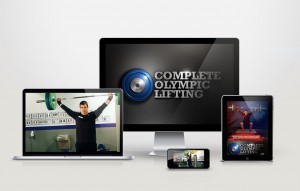Shoulder Strength and Stability for All Athletes
By Dustin A. Hada

There is a great need for strength and stability in the shoulder joint in all sports. The shoulder is one of the most structurally complex joints in the body, thus making it one of the most vulnerable to injury. Shoulder injuries in athletics are far too common and are some of the most impacting injuries on performance. With lengthy rehab times and a continual risk of reoccurrence, prevention of shoulder injury is paramount in athletics. Some of the most common reasons for shoulder injuries are strength imbalances and overuse.
Shoulder Training Principles
Common exercises that are used to strengthen the shoulder are the bench press, military press, and dumbbell raises. These exercises are very effective in strengthening the larger muscles of the shoulder, but often neglect the smaller stabilizing muscles that surround the joint. This creates strength imbalances that can lead to injury. I believe in the use of multi-plane free weight or body weight shoulder movements, which have limited or no body support; exercises performed on two feet, or in the pushup or power position. The weight of the athlete is on two feet whenever possible, not laying or sitting on a bench. This activates the core, and reinforces power postures that are used in athletics. Multi-plane exercises mimic the performance stresses of the sport, and increase proprioperception of the shoulder joint. This type of training also minimizes strength imbalances by strengthening stabilizer muscles and increasing range of motion.
Body Weight Exercises
Towel Pull-ups: Hang 2 towels that are about 2 inches in diameter from a pull-up bar (I use ½ of a towel taped in 4 places). Place them shoulder width apart. Do pull-ups from the towel until failure. When failure is achieved, lift your ankles and a spotter will assist you by lifting at the ankles. This is a great exercise for the lats as well as a very effective grip strengthener.
Pull-up/Pushup Complex: Place a barbell in a rack about 3 feet off the floor. Get under the bar as if you were going to bench press. Place the hands a little wider than shoulder width. With heels on the floor, and a straight, tight torso, pull yourself up to the bar so that the bar is around the nipple line on the chest. Do as many reps as you can with a tight torso, when the torso can not remain tight, the set is complete. Immediately after completion of the pull-ups turn over and do as many perfect pushups as possible with a tight torso and full depth.
Pushup Walkovers: Use a 12-14 inch box or a stack of 6 rubber bumper plates in a tower. Start on the left side of the box in the up pushup position with your feet in line with the middle of the box. Do a pushup, and then walk the right hand up onto the box, followed by the left hand, then down with the right hand, then down with the left hand. Do a pushup, then walk back over the top and do a pushup. Count only the pushups done on the left side and complete sets of 8-10. This exercise has to be performed with a tight torso through the entire movement. I love this exercise for stability of the shoulder and it is a great strengthener for some often neglected muscles.
Feet on Ball Punch-ups: Get in a feet-together up pushup position with a Swiss ball of any size under your toes. With a tight torso, perform a punch-up. Punch-ups are pushups that are lowered slowly and exploded out of the bottom. Sets of 8-10 are great. You may need to place the hands a little wider than a normal pushup until better shoulder stability and balance is achieved.
Plate on Ball Punch-ups: Place a plate (we use a 10kg. bumper) on top of a small Swiss ball. Get in the up pushup position with the feet together and torso tight. Grip the plate and lower the chest to 2 inches above the plate and punch up. The torso MUST remain tight throughout the exercise.
Second Hand: Start in the up pushup position, with feet together and torso tight. With the feet in the same spot on the floor, walk your torso around, like the second hand of a clock. Lead with the inside hand and do not cross over. Keep the torso tight and level the entire time. When you reach the starting spot return the other way. Two circles is one set.
Plate Movements:
Plate Raises: Start in a power position (knees and hips bent, torso tight and upright) with a 20-25kg plate in your hands, and between your knees. Explode the plate up so that the hole in the plate is at eye level. Slowly and in control, lower the plate back to the starting position. Keep the elbows tight and do not drop your hips when raising the plate. Never droop or roll the back, keep it as tight as possible.
Plate Throws: Have partners stand about 6 feet apart in a power position, one partner will start with a rubber bumper plate (20-25kg). Keep the elbows and torso tight and straight. Toss the plate to the other partner, aiming the hole of the plate at his chest. The receiver will allow gravity to lower the plate between his knees, but must maintain control of the plate. This exercise takes some practice and should be started with lower weights. One partner counts and sets of 8-10 are good.
Around the World: Take a 20-25kg plate in both hands. Stand upright with tall, tight, military posture. With the head still and looking straight ahead, take the hole of the plate around the equator of the head (eyes, ears, back of the head). Make sure that the plate is low enough in the back of the head. This exercise is a speed movement; you want to go as fast as you can. This isNOT a head movement; reach far with the hands so that the head can remain still. Go around the eyes 8 times each way for 1 set. I like to use 3-4 sets with my athletes.
Recommended Athletes' Acceleration
Products
About the Author:
Dustin A. Hada USAW
S&C Coordinator, Olivet Nazarene University




0 Comments for “Shoulder Strength and Stability for All Athletes”